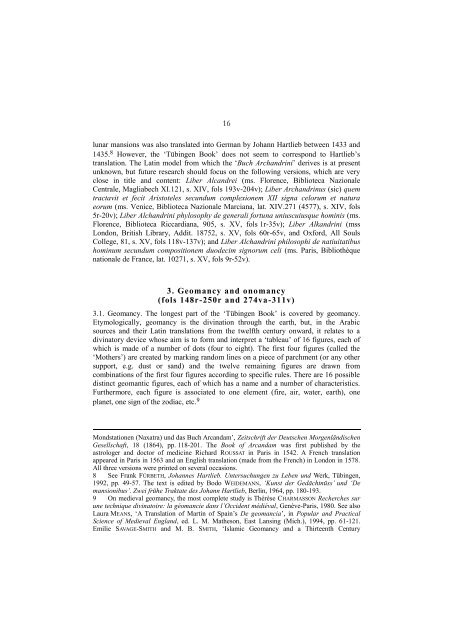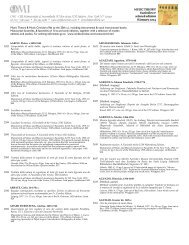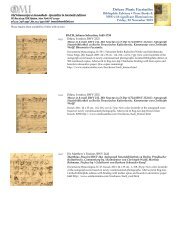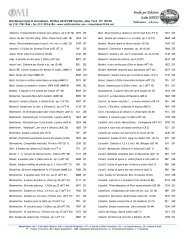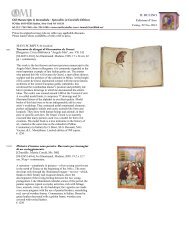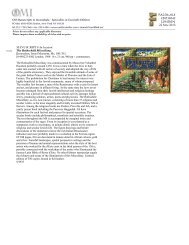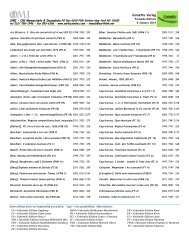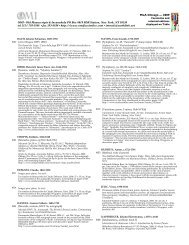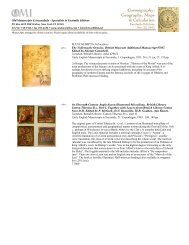CIMA 63 Titel Inhalt
CIMA 63 Titel Inhalt
CIMA 63 Titel Inhalt
Erfolgreiche ePaper selbst erstellen
Machen Sie aus Ihren PDF Publikationen ein blätterbares Flipbook mit unserer einzigartigen Google optimierten e-Paper Software.
16<br />
lunar mansions was also translated into German by Johann Hartlieb between 1433 and<br />
1435. 8 However, the ‗Tübingen Book‘ does not seem to correspond to Hartlieb‘s<br />
translation. The Latin model from which the ‗Buch Archandrini‘ derives is at present<br />
unknown, but future research should focus on the following versions, which are very<br />
close in title and content: Liber Alcandrei (ms. Florence, Biblioteca Nazionale<br />
Centrale, Magliabech XI.121, s. XIV, fols 193v-204v); Liber Archandrinus (sic) quem<br />
tractavit et fecit Aristoteles secundum complexionem XII signa celorum et natura<br />
eorum (ms. Venice, Biblioteca Nazionale Marciana, lat. XIV.271 (4577), s. XIV, fols<br />
5r-20v); Liber Alchandrini phylosophy de generali fortuna uniuscuiusque hominis (ms.<br />
Florence, Biblioteca Riccardiana, 905, s. XV, fols 1r-35v); Liber Alkandrini (mss<br />
London, British Library, Addit. 18752, s. XV, fols 60r-65v, and Oxford, All Souls<br />
College, 81, s. XV, fols 118v-137v); and Liber Alchandrini philosophi de natiuitatibus<br />
hominum secundum compositionem duodecim signorum celi (ms. Paris, Bibliothèque<br />
nationale de France, lat. 10271, s. XV, fols 9r-52v).<br />
3. Geomancy and onomancy<br />
(fols 148r-250r and 274va-311v)<br />
3.1. Geomancy. The longest part of the ‗Tübingen Book‘ is covered by geomancy.<br />
Etymologically, geomancy is the divination through the earth, but, in the Arabic<br />
sources and their Latin translations from the twelfth century onward, it relates to a<br />
divinatory device whose aim is to form and interpret a ‗tableau‘ of 16 figures, each of<br />
which is made of a number of dots (four to eight). The first four figures (called the<br />
‗Mothers‘) are created by marking random lines on a piece of parchment (or any other<br />
support, e.g. dust or sand) and the twelve remaining figures are drawn from<br />
combinations of the first four figures according to specific rules. There are 16 possible<br />
distinct geomantic figures, each of which has a name and a number of characteristics.<br />
Furthermore, each figure is associated to one element (fire, air, water, earth), one<br />
planet, one sign of the zodiac, etc. 9<br />
Mondstationen (Naxatra) und das Buch Arcandam‘, Zeitschrift der Deutschen Morgenländischen<br />
Gesellschaft, 18 (1864), pp. 118-201. The Book of Arcandam was first published by the<br />
astrologer and doctor of medicine Richard ROUSSAT in Paris in 1542. A French translation<br />
appeared in Paris in 15<strong>63</strong> and an English translation (made from the French) in London in 1578.<br />
All three versions were printed on several occasions.<br />
8 See Frank FÜRBETH, Johannes Hartlieb. Untersuchungen zu Leben und Werk, Tübingen,<br />
1992, pp. 49-57. The text is edited by Bodo WEIDEMANN, ‘Kunst der Gedächtnüss’ und ‘De<br />
mansionibus’. Zwei frühe Traktate des Johann Hartlieb, Berlin, 1964, pp. 180-193.<br />
9 On medieval geomancy, the most complete study is Thérèse CHARMASSON Recherches sur<br />
une technique divinatoire: la géomancie dans l’Occident médiéval, Genève-Paris, 1980. See also<br />
Laura MEANS, ‗A Translation of Martin of Spain‘s De geomancia‘, in Popular and Practical<br />
Science of Medieval England, ed. L. M. Matheson, East Lansing (Mich.), 1994, pp. 61-121.<br />
Emilie SAVAGE-SMITH and M. B. SMITH, ‗Islamic Geomancy and a Thirteenth Century


